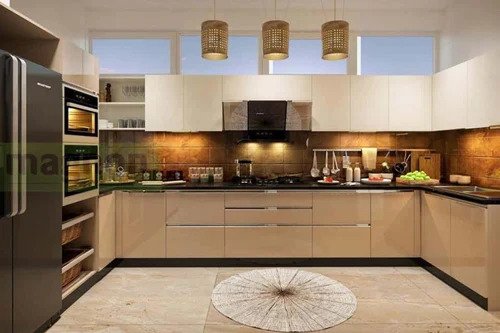How to Create Perfect Modular Kitchen Interior Design for Your Home
A modular kitchen is more than just a cooking space; it is the heart of the home, combining functionality with style.

With modular kitchen interior design demanding efficient and aesthetic designs, modular kitchens have become a go-to solution for homeowners. Here's a comprehensive guide to creating the perfect modular kitchen interior design tailored to your needs.
Understand the Basics of Modular Kitchens
A modular kitchen is a contemporary concept that uses pre-made cabinet modules for optimal space utilization and convenience. It is designed with functionality and aesthetics in mind:
Components: Cabinets, drawers, shelves, countertops, and appliances.
Customization: Allows for tailored layouts, materials, and finishes.
Benefits: Maximizes space, offers easy maintenance, and ensures a sleek, modern look.
Choose the Right Layout
The layout is the foundation of a well-designed modular kitchen. Select one that suits your space and cooking habits:
L-Shaped Kitchen: Ideal for small to medium spaces; offers efficient work zones.
U-Shaped Kitchen: Suitable for larger spaces; provides ample storage and counter space.
Straight Kitchen: A minimalist design for compact spaces, aligning all elements along one wall.
Island Kitchen: Perfect for open-plan homes; adds extra workspace and seating.
Parallel Kitchen: Best for narrow spaces; ensures a functional work triangle.
Focus on the Work Triangle
The work triangle connects the three main areas of a kitchen—the sink, stove, and refrigerator—to ensure seamless movement:
Distance: Keep each side of the triangle between 4 to 9 feet.
Accessibility: Ensure clear paths between the points for efficient workflow.
Select Quality Materials and Finishes
Materials and finishes play a crucial role in the durability and aesthetics of your kitchen:
Cabinets:
MDF or HDF: Affordable and versatile options.
Plywood: Durable and moisture-resistant.
Acrylic: Glossy finish for a luxurious look.
Laminate: Budget-friendly with a variety of textures.
Countertops:
Granite: Durable and heat-resistant.
Quartz: Sleek, non-porous, and available in multiple colors.
Marble: Elegant but requires regular maintenance.
Backsplash:
Tiles: Easy to clean and available in various designs.
Glass: Modern and reflective, adding depth to the space.
Stone: Rustic and durable for a timeless appeal.
Incorporate Smart Storage Solutions
Efficient storage is the hallmark of a modular kitchen. Incorporate smart solutions to keep your space organized:
Pull-Out Drawers: Ideal for utensils, spices, and small appliances.
Corner Units: Use carousel or magic corner systems for hard-to-reach areas.
Tall Cabinets: Maximize vertical space for pantry storage.
Drawer Dividers: Keep cutlery and tools neatly arranged.
Overhead Cabinets: Utilize space above the counter for storing less frequently used items.
Prioritize Lighting
Good lighting enhances both functionality and ambiance in the kitchen:
Task Lighting: Focused lights under cabinets for chopping and cooking.
Ambient Lighting: Ceiling lights or pendant lamps for overall brightness.
Accent Lighting: LED strips to highlight specific areas or features.
Choose Energy-Efficient Appliances
Modern kitchens demand energy-efficient and space-saving appliances:
Built-In Appliances: Seamlessly integrate ovens, microwaves, and dishwashers.
Refrigerator: Choose models with smart features and adequate storage.
Cooktop and Chimney: Opt for sleek designs with effective ventilation.
Dishwasher: A compact model can save time and water.
Optimize Ventilation
Proper ventilation is essential to maintain air quality and prevent lingering odors:
Chimneys: Install a high-suction chimney to expel smoke and grease.
Exhaust Fans: Place them near windows for effective airflow.
Windows: Design large windows for natural ventilation and light.
Add Personal Touches
Infuse your personality into the design for a unique and welcoming space:
Color Schemes: Choose a palette that complements your home’s overall decor.
Decorative Elements: Add open shelves for displaying crockery or plants.
Textiles: Use patterned rugs or curtains to soften the look.
Keep It Easy to Maintain
A modular kitchen should be as easy to clean as it is to use:
Smooth Surfaces: Opt for finishes that are stain-resistant and easy to wipe.
Proper Sealing: Ensure countertops and backsplashes are well-sealed to prevent water damage.
Trash Management: Install pull-out bins for waste segregation.
Budgeting and Planning
Plan your modular kitchen design within a realistic budget:
Initial Estimate: Determine the total cost, including cabinets, countertops, appliances, and labor.
Prioritize Needs: Focus on essential features first, then add upgrades.
Consult Experts: Work with experienced designers to avoid costly mistakes.
Conclusion
Creating the perfect modular kitchen interior design is a blend of thoughtful planning, quality materials, and personalized touches. By focusing on functionality and aesthetics, you can design a space that not only meets your daily needs but also adds value to your home.
What's Your Reaction?

















.jpg)
.jpg)
